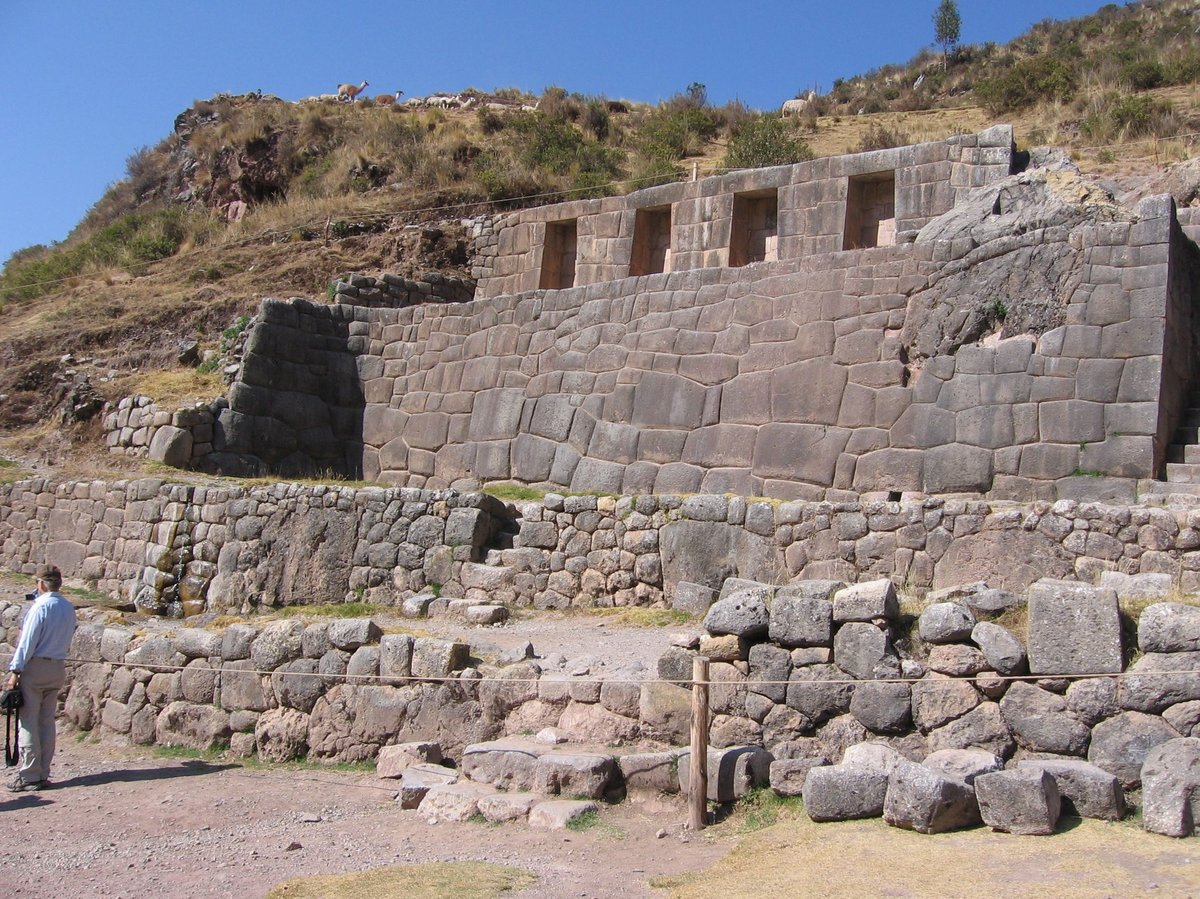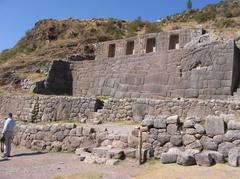
Visiting Tambomachay: Hours, Tickets, and Tips
Date: 18/07/2024
Introduction
Tambomachay, often referred to as the ‘Bath of the Inca,’ is a captivating archaeological site located near Cusco, Peru, in the Wanchaq District. Renowned for its sophisticated hydraulic engineering, Tambomachay offers a window into the advanced engineering skills and spiritual practices of the Inca civilization. This site, believed to have been constructed during the reign of Inca Pachacuti in the 15th century, features a series of aqueducts, canals, and waterfalls that run through terraced rocks (Cusco Region Archaeological Park). The precision of the water flow and the architectural marvels suggest that Tambomachay had significant ceremonial or religious functions, possibly related to water worship (Water Worship in Inca Religion). This guide aims to provide comprehensive visitor information, historical context, and travel tips to ensure an enriching experience at Tambomachay.
Table of Contents
Historical Background of Tambomachay
Pre-Inca Period
The region where Tambomachay is situated has a rich history that predates the Inca civilization. Archaeological evidence suggests that the area was inhabited by pre-Inca cultures, such as the Killke, who occupied the Cusco region from around 900 to 1200 AD. These early inhabitants laid the groundwork for the sophisticated agricultural and architectural techniques that the Incas would later adopt and refine.
Inca Empire
Tambomachay is believed to have been constructed during the reign of Inca Pachacuti in the 15th century. This period marked the height of the Inca Empire, which extended across large parts of modern-day Peru, Ecuador, Bolivia, Argentina, Chile, and Colombia. The site is located approximately 8 kilometers (5 miles) from Cusco, the capital of the Inca Empire, and is situated at an altitude of 3,700 meters (12,139 feet) above sea level.
Architectural Significance
Tambomachay is renowned for its sophisticated hydraulic engineering. The site features a series of aqueducts, canals, and waterfalls that run through terraced rocks. The waterworks are fed by a natural spring, and the precision with which the water flows through the stone channels is a testament to the advanced engineering skills of the Incas. The exact purpose of these waterworks remains a subject of debate among historians and archaeologists. Some theories suggest that Tambomachay served as a spa or bathing area for the Inca elite, while others propose that it had a ceremonial or religious function, possibly related to water worship.
Religious and Ceremonial Importance
Water was a vital element in Inca cosmology and religion. The Incas believed in the concept of ‘Pacarina,’ which refers to sacred places of origin, often associated with water sources. Tambomachay’s intricate waterworks and its proximity to other significant Inca sites, such as Puka Pukara and Qenqo, suggest that it may have been part of a larger ceremonial complex. The site’s alignment with the solstices and equinoxes further indicates its possible use for astronomical observations and rituals.
Spanish Conquest and Colonial Period
The Spanish conquest of the Inca Empire in the 16th century led to significant changes in the region. Many Inca sites were destroyed or repurposed by the Spanish colonizers. However, Tambomachay managed to survive relatively intact, possibly due to its remote location and the difficulty of accessing the site. During the colonial period, the site was largely neglected, and it wasn’t until the 19th and 20th centuries that it began to attract the attention of archaeologists and historians.
Modern Rediscovery and Preservation
Tambomachay was first documented by European explorers in the 19th century. The site gained more scholarly attention in the early 20th century, particularly after the rediscovery of Machu Picchu by Hiram Bingham in 1911 (Hiram Bingham and the Rediscovery of Machu Picchu). Since then, Tambomachay has been the subject of numerous archaeological studies aimed at understanding its construction, function, and significance within the Inca Empire.
In recent years, efforts have been made to preserve and protect Tambomachay from environmental and human-induced damage. The site is now part of the Cusco Region’s protected archaeological park, and measures have been implemented to control tourist access and prevent erosion. These efforts are crucial for maintaining the integrity of the site for future generations.
Cultural Legacy
Tambomachay continues to hold cultural significance for the indigenous communities of the Cusco region. The site is often included in traditional Andean rituals and ceremonies, particularly those related to water and agriculture. Local guides and shamans frequently incorporate Tambomachay into their narratives of Inca history and spirituality, emphasizing its role as a place of purification and renewal.
Visitor Information
Visiting Hours and Tickets
Tambomachay is open to visitors year-round, typically from 7:00 AM to 6:00 PM. It’s advisable to check the official website or contact local authorities for the most current visiting hours and ticket information. Tickets can be purchased at the site or as part of a comprehensive tourist ticket that includes access to other nearby attractions.
Travel Tips
- Best Time to Visit: The best time to visit Tambomachay is during the dry season, from May to September, when the weather is more favorable for outdoor activities.
- Accessibility: The site is accessible from Cusco by car, taxi, or as part of a guided tour. The hike is relatively easy, but the high altitude can be challenging for some visitors, so it’s recommended to acclimate in Cusco for a few days before visiting.
- Guided Tours: Consider hiring a local guide to enrich your experience with detailed historical and cultural insights.
- What to Bring: Comfortable walking shoes, water, sunscreen, and a hat are essential items for your visit.
Nearby Attractions
- Puka Pukara: Another nearby Inca site known for its military ruins and stunning views of the surrounding valleys.
- Qenqo: A ceremonial site featuring intricate stone carvings and subterranean passages.
- Sacsayhuamán: A massive fortress offering panoramic views of Cusco and an impressive display of Inca stone masonry.
FAQ
What are the visiting hours for Tambomachay?
Tambomachay is open from 7:00 AM to 6:00 PM daily. However, it’s advisable to check current visiting hours on the official website or by contacting local authorities.
How much are the tickets for Tambomachay?
Ticket prices vary, and visitors can purchase individual tickets or opt for a comprehensive tourist ticket that includes other nearby attractions. Prices and availability can be confirmed on the official website or at the entrance.
Is it necessary to hire a guide?
While not mandatory, hiring a local guide is highly recommended to gain deeper insights into the history and significance of Tambomachay.
Conclusion
Tambomachay is a testament to the Inca civilization’s engineering prowess and spiritual depth. Whether you’re a history enthusiast, a cultural explorer, or a curious traveler, Tambomachay offers an enriching experience. Plan your visit, immerse yourself in the history, and explore the wonders of this incredible archaeological site. For more information and updates, follow us on social media or check out our related articles.

